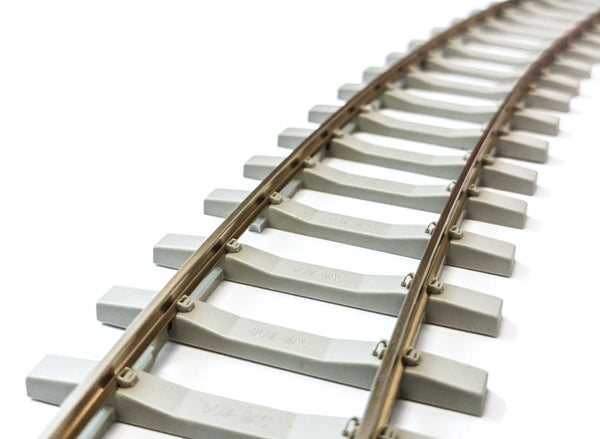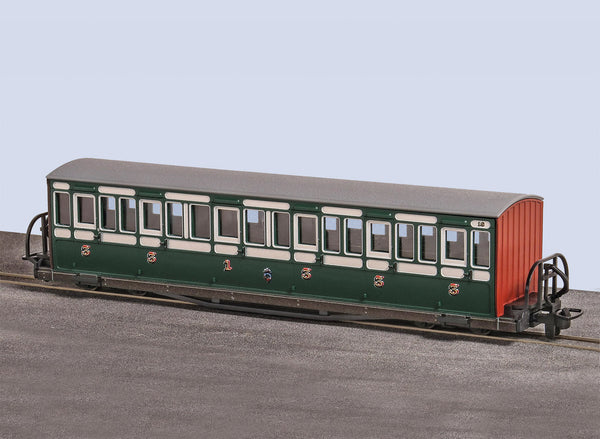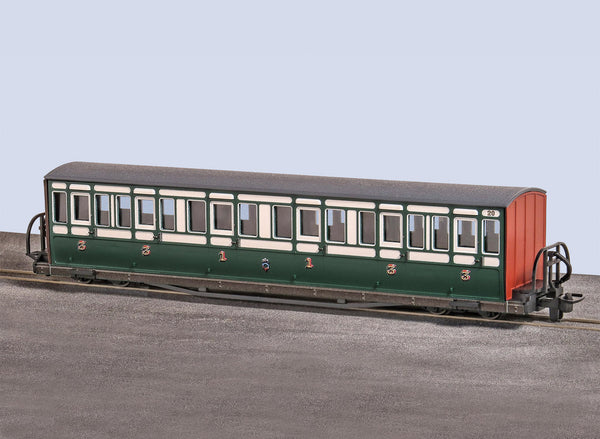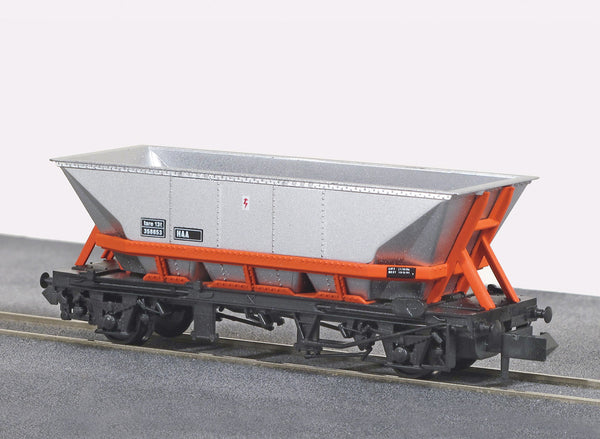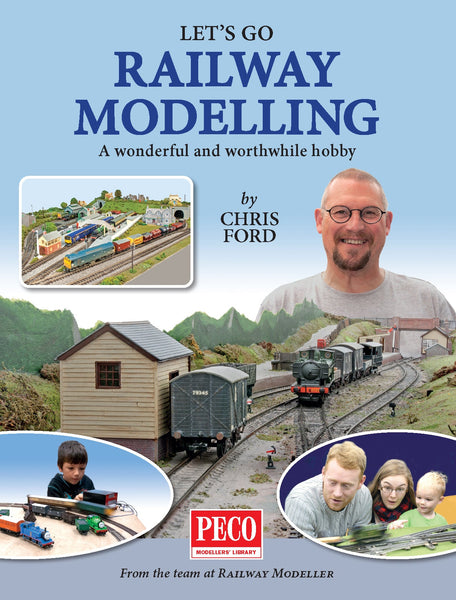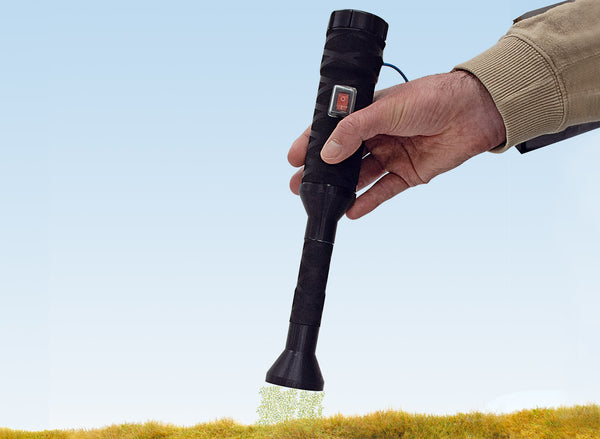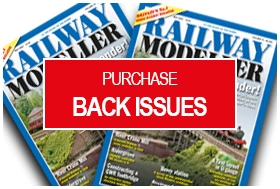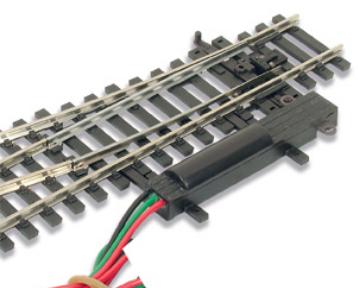DURCHSUCHEN SIE PECO-PRODUKTE
Stöbern Sie durch unser komplettes Produktportfolio.
108 Products Found
2025 Railway Modeller Special (The Annual)
The wonderful creative pastime of model railways is celebrated in the 2025 Railway Modeller Special, produced by the publisher of Railway Modeller, the UK’s market-leading model railway title with the highest ABC audited readership.
Having recently marked the title’s 75th year of publication, Railway Modeller remains unique in British model railway publishing, as it is part of a company that is long-associated with the industry, namely the world famous PECO model railway brand.
In this special publication, we journey along the East Coast Main Line from King’s Cross to Edinburgh Waverley – in model form! Another rail route profiled is the narrow gauge Ffestiniog Railway in North Wales, including an overview of this line’s remarkable history and suggestions for how it can be re-created in miniature. We also step back in time to the Edwardian era and make a return visit to the London South Western Railway station of Semley, a stunning layout created by Martin Finney.
We also meet the team at Ellis Clark Trains and find out about the future plans for this enterprising model railway business; take a tour around Cockshute – a 1970s diesel and electric depot in OO; look at a selection of models based on steam locomotive designs that never left the drawing board; and much more besides – enjoy!
Kitbuilder-Werkzeugset
Ein speziell ausgewählter Werkzeugsatz von erfahrenen Modellbauern hier bei PECO für den Bausatzbau. Diese Werkzeuge sind für alle Modellbauer von entscheidender Bedeutung. Dazu gehört auch Expertenwissen in Form eines nützlichen Leitfadens, der Ihnen von den Experten von Railway Modeller zur Verfügung gestellt wird.
Beinhaltet:
- Anguss- und Kunststoffschneider
- Feine Pinzette
- Abbrechmesser mit 10 Ersatzklingen
- Set mit 4 Nadelfeilen
- Pinsel der Größe Nr. 0
- Pinsel der Größe Nr. 4
- A4-Schneidematte
- 150 mm/6 Zoll Stahlmaßstab
- Zeigt Ihnen, wie es geht: „Bausatzbau für Anfänger“
Kitbuilder-Werkzeugset
Ein speziell ausgewählter Werkzeugsatz von erfahrenen Modellbauern hier bei PECO für den Bausatzbau. Diese Werkzeuge sind für alle Modellbauer von entscheidender Bedeutung. Dazu gehört auch Expertenwissen in Form eines nützlichen Leitfadens, der Ihnen von den Experten von Railway Modeller zur Verfügung gestellt wird.
Beinhaltet:
- Anguss- und Kunststoffschneider
- Feine Pinzette
- Abbrechmesser mit 10 Ersatzklingen
- Set mit 4 Nadelfeilen
- Pinsel der Größe Nr. 0
- Pinsel der Größe Nr. 4
- A4-Schneidematte
- 150 mm/6 Zoll Stahlmaßstab
- Zeigt Ihnen, wie es geht: „Bausatzbau für Anfänger“
BR 16t Mineral Wagon, Coal 16VB, Fitted, Bauxite
Ganzzüge mit Spezialladungen sind ein Merkmal der modernen Eisenbahn. Alle Peco-Wagen verfügen über freilaufende Räder mit Steckachsen. Die ELC-Kupplung ist zwar mit den standardmäßigen N-Spur-Kupplungen kompatibel, hält jedoch einen realistischen Abstand zwischen Fahrzeugen und ermöglicht die Verwendung des elektromagnetischen Entkopplers PL-25 zum Fernentkuppeln.
BR 16t Mineral Wagon, Coal 16VB, Fitted, Bauxite
Ganzzüge mit Spezialladungen sind ein Merkmal der modernen Eisenbahn. Alle Peco-Wagen verfügen über freilaufende Räder mit Steckachsen. Die ELC-Kupplung ist zwar mit den standardmäßigen N-Spur-Kupplungen kompatibel, hält jedoch einen realistischen Abstand zwischen Fahrzeugen und ermöglicht die Verwendung des elektromagnetischen Entkopplers PL-25 zum Fernentkuppeln.
BR Vanfit Wagon - Bass Brewery
Ganzzüge mit Spezialladungen sind ein Merkmal der modernen Eisenbahn. Alle Peco-Wagen verfügen über freilaufende Räder mit Steckachsen. Die ELC-Kupplung ist zwar mit den standardmäßigen N-Spur-Kupplungen kompatibel, hält jedoch einen realistischen Abstand zwischen Fahrzeugen und ermöglicht die Verwendung des elektromagnetischen Entkopplers PL-25 zum Fernentkuppeln.
BR Vanfit Wagon - Blue Circle Cement
Ganzzüge mit Spezialladungen sind ein Merkmal der modernen Eisenbahn. Alle Peco-Wagen verfügen über freilaufende Räder mit Steckachsen. Die ELC-Kupplung ist zwar mit den standardmäßigen N-Spur-Kupplungen kompatibel, hält jedoch einen realistischen Abstand zwischen Fahrzeugen und ermöglicht die Verwendung des elektromagnetischen Entkopplers PL-25 zum Fernentkuppeln.
BR Vanfit Wagon - Colman's Mustard
Ganzzüge mit Spezialladungen sind ein Merkmal der modernen Eisenbahn. Alle Peco-Wagen verfügen über freilaufende Räder mit Steckachsen. Die ELC-Kupplung ist zwar mit den standardmäßigen N-Spur-Kupplungen kompatibel, hält jedoch einen realistischen Abstand zwischen Fahrzeugen und ermöglicht die Verwendung des elektromagnetischen Entkopplers PL-25 zum Fernentkuppeln.
BR Vanfit Wagon - Freight
Ganzzüge mit Spezialladungen sind ein Merkmal der modernen Eisenbahn. Alle Peco-Wagen verfügen über freilaufende Räder mit Steckachsen. Die ELC-Kupplung ist zwar mit den standardmäßigen N-Spur-Kupplungen kompatibel, hält jedoch einen realistischen Abstand zwischen Fahrzeugen und ermöglicht die Verwendung des elektromagnetischen Entkopplers PL-25 zum Fernentkuppeln.
BR Vanfit Wagon - Fyffes Bananas
Ganzzüge mit Spezialladungen sind ein Merkmal der modernen Eisenbahn. Alle Peco-Wagen verfügen über freilaufende Räder mit Steckachsen. Die ELC-Kupplung ist zwar mit den standardmäßigen N-Spur-Kupplungen kompatibel, hält jedoch einen realistischen Abstand zwischen Fahrzeugen und ermöglicht die Verwendung des elektromagnetischen Entkopplers PL-25 zum Fernentkuppeln.
BR Vanfit, Plank Side
Ganzzüge mit Spezialladungen sind ein Merkmal der modernen Eisenbahn. Alle Peco-Wagen verfügen über freilaufende Räder mit Steckachsen. Die ELC-Kupplung ist zwar mit den standardmäßigen N-Spur-Kupplungen kompatibel, hält jedoch einen realistischen Abstand zwischen Fahrzeugen und ermöglicht die Verwendung des elektromagnetischen Entkopplers PL-25 zum Fernentkuppeln.
BR Vanfit, Plywood Side
Ganzzüge mit Spezialladungen sind ein Merkmal der modernen Eisenbahn. Alle Peco-Wagen verfügen über freilaufende Räder mit Steckachsen. Die ELC-Kupplung ist zwar mit den standardmäßigen N-Spur-Kupplungen kompatibel, hält jedoch einen realistischen Abstand zwischen Fahrzeugen und ermöglicht die Verwendung des elektromagnetischen Entkopplers PL-25 zum Fernentkuppeln.
Kitbuilder-Werkzeugset
Ein speziell ausgewählter Werkzeugsatz von erfahrenen Modellbauern hier bei PECO für den Bausatzbau. Diese Werkzeuge sind für alle Modellbauer von entscheidender Bedeutung. Dazu gehört auch Expertenwissen in Form eines nützlichen Leitfadens, der Ihnen von den Experten von Railway Modeller zur Verfügung gestellt wird.
Beinhaltet:
- Anguss- und Kunststoffschneider
- Feine Pinzette
- Abbrechmesser mit 10 Ersatzklingen
- Set mit 4 Nadelfeilen
- Pinsel der Größe Nr. 0
- Pinsel der Größe Nr. 4
- A4-Schneidematte
- 150 mm/6 Zoll Stahlmaßstab
- Zeigt Ihnen, wie es geht: „Bausatzbau für Anfänger“
Ex-BR 16t Mineral Wagon, NCB
Ganzzüge mit Spezialladungen sind ein Merkmal der modernen Eisenbahn. Alle Peco-Wagen verfügen über freilaufende Räder mit Steckachsen. Die ELC-Kupplung ist zwar mit den standardmäßigen N-Spur-Kupplungen kompatibel, hält jedoch einen realistischen Abstand zwischen Fahrzeugen und ermöglicht die Verwendung des elektromagnetischen Entkopplers PL-25 zum Fernentkuppeln.
Ex-BR Iron Ore Tippler, NCB
Ganzzüge mit Spezialladungen sind ein Merkmal der modernen Eisenbahn. Alle Peco-Wagen verfügen über freilaufende Räder mit Steckachsen. Die ELC-Kupplung ist zwar mit den standardmäßigen N-Spur-Kupplungen kompatibel, hält jedoch einen realistischen Abstand zwischen Fahrzeugen und ermöglicht die Verwendung des elektromagnetischen Entkopplers PL-25 zum Fernentkuppeln.
Flexible Track with Concrete Sleeper
This track models the most common form of concrete sleepering in use in Britain today, with flat bottom rail. PECO Streamline O Gauge Code 143 - Concrete Flexible Track.
SL-702FB PECO Streamline O Code 143 Flexible Track & Concrete SleeperTie
Flat bottom rail, 914mm, 3ft length / Nickel silver rail
View the film here: 
FR Long 'Bowsider' Coach - Colonel Stephens No.19
The Ffestiniog Railway operated two pairs of bogie coaches numbered 17-20 and built by Brown Marshalls & Co and Gloucester Wagon Co. They were known as ‘Bowsiders’ because of the tumblehome shape of their sides. Numbers 17 and 18, built in 1876 are shorter with one 1st class compartment. Numbers 19 and 20, built in 1879 are longer with two 1st class compartments. All four are still in service on the Ffestiniog Railway today.
In the 1920s the elaborate liveries of the Victorian era were replaced with a simple scheme of green with red end panels. It became known as the ‘Colonel Stephens’ livery, after the General Manager of the Ffestiniog Railway from 1925 until his passing in 1931. The colour scheme was used until the end of passenger operations in 1939, sometimes alongside other colours such as yellow, in the mid 1930s.
Green with red ends was applied to carriage No.20 once again from 2005 until 2024, as depicted by GR-623B.
FR Long 'Bowsider' Coach - Colonel Stephens No.20
The Ffestiniog Railway operated two pairs of bogie coaches numbered 17-20 and built by Brown Marshalls & Co and Gloucester Wagon Co. They were known as ‘Bowsiders’ because of the tumblehome shape of their sides. Numbers 17 and 18, built in 1876 are shorter with one 1st class compartment. Numbers 19 and 20, built in 1879 are longer with two 1st class compartments. All four are still in service on the Ffestiniog Railway today.
In the 1920s the elaborate liveries of the Victorian era were replaced with a simple scheme of green with red end panels. It became known as the ‘Colonel Stephens’ livery, after the General Manager of the Ffestiniog Railway from 1925 until his passing in 1931. The colour scheme was used until the end of passenger operations in 1939, sometimes alongside other colours such as yellow, in the mid 1930s.
Green with red ends was applied to carriage No.20 once again from 2005 until 2024, as depicted by GR-623B.
FR Long 'Bowsider' Coach - Red & Cream No.19
The Ffestiniog Railway operated two pairs of bogie coaches numbered 17-20 and built by Brown Marshalls & Co and Gloucester Wagon Co. They were known as ‘Bowsiders’ because of the tumblehome shape of their sides. Numbers 17 and 18, built in 1876 are shorter with one 1st class compartment. Numbers 19 and 20, built in 1879 are longer with two 1st class compartments. All four are still in service on the Ffestiniog Railway today.
The red and cream livery was first applied to a rake of carriages in 1987 for the ‘Mountain Prince’ train service. Carriage 20 was the first Bowsider to appear in the livery.
Carriages 17 and 18 had cream applied to the full upper half of the carriage. 17 had the mouldings reinstated in 1990 as depicted by GR-602A. 18 continued to have cream across the upper half throughout its time in the scheme, as represented by GR-602B. Note the ‘Brown Marshalls & Co. Ltd’ builders plate printed on the ends of the carriage.
All four Bowsiders were repainted into historic liveries in the 2000s, but the red and cream colour scheme is still seen today on the more modern carriages
FR Long 'Bowsider' Coach - Red & Cream No.20
The Ffestiniog Railway operated two pairs of bogie coaches numbered 17-20 and built by Brown Marshalls & Co and Gloucester Wagon Co. They were known as ‘Bowsiders’ because of the tumblehome shape of their sides. Numbers 17 and 18, built in 1876 are shorter with one 1st class compartment. Numbers 19 and 20, built in 1879 are longer with two 1st class compartments. All four are still in service on the Ffestiniog Railway today.
The red and cream livery was first applied to a rake of carriages in 1987 for the ‘Mountain Prince’ train service. Carriage 20 was the first Bowsider to appear in the livery.
Carriages 17 and 18 had cream applied to the full upper half of the carriage. 17 had the mouldings reinstated in 1990 as depicted by GR-602A. 18 continued to have cream across the upper half throughout its time in the scheme, as represented by GR-602B. Note the ‘Brown Marshalls & Co. Ltd’ builders plate printed on the ends of the carriage.
All four Bowsiders were repainted into historic liveries in the 2000s, but the red and cream colour scheme is still seen today on the more modern carriages
FR Short 'Bowsider' Bogie Coach - Early Preservation - Green 17
FR Short 'Bowsider' Bogie Coach - Early Preservation - Green 18
FR Short 'Bowsider' Bogie Coach - Early Preservation - Green 19
FR Short 'Bowsider' Bogie Coach - Early Preservation - Green 20
FR Short 'Bowsider' Coach - Colonel Stephens No.17
The Ffestiniog Railway operated two pairs of bogie coaches numbered 17-20 and built by Brown Marshalls & Co and Gloucester Wagon Co. They were known as ‘Bowsiders’ because of the tumblehome shape of their sides. Numbers 17 and 18, built in 1876 are shorter with one 1st class compartment. Numbers 19 and 20, built in 1879 are longer with two 1st class compartments. All four are still in service on the Ffestiniog Railway today.
In the 1920s the elaborate liveries of the Victorian era were replaced with a simple scheme of green with red end panels. It became known as the ‘Colonel Stephens’ livery, after the General Manager of the Ffestiniog Railway from 1925 until his passing in 1931. The colour scheme was used until the end of passenger operations in 1939, sometimes alongside other colours such as yellow, in the mid 1930s.
Green with red ends was applied to carriage No.20 once again from 2005 until 2024, as depicted by GR-623B.
FR Short 'Bowsider' Coach - Colonel Stephens No.18
The Ffestiniog Railway operated two pairs of bogie coaches numbered 17-20 and built by Brown Marshalls & Co and Gloucester Wagon Co. They were known as ‘Bowsiders’ because of the tumblehome shape of their sides. Numbers 17 and 18, built in 1876 are shorter with one 1st class compartment. Numbers 19 and 20, built in 1879 are longer with two 1st class compartments. All four are still in service on the Ffestiniog Railway today.
In the 1920s the elaborate liveries of the Victorian era were replaced with a simple scheme of green with red end panels. It became known as the ‘Colonel Stephens’ livery, after the General Manager of the Ffestiniog Railway from 1925 until his passing in 1931. The colour scheme was used until the end of passenger operations in 1939, sometimes alongside other colours such as yellow, in the mid 1930s.
Green with red ends was applied to carriage No.20 once again from 2005 until 2024, as depicted by GR-623B.
FR Short 'Bowsider' Coach - Red & Cream No.17
The Ffestiniog Railway operated two pairs of bogie coaches numbered 17-20 and built by Brown Marshalls & Co and Gloucester Wagon Co. They were known as ‘Bowsiders’ because of the tumblehome shape of their sides. Numbers 17 and 18, built in 1876 are shorter with one 1st class compartment. Numbers 19 and 20, built in 1879 are longer with two 1st class compartments. All four are still in service on the Ffestiniog Railway today.
The red and cream livery was first applied to a rake of carriages in 1987 for the ‘Mountain Prince’ train service. Carriage 20 was the first Bowsider to appear in the livery.
Carriages 17 and 18 had cream applied to the full upper half of the carriage. 17 had the mouldings reinstated in 1990 as depicted by GR-602A. 18 continued to have cream across the upper half throughout its time in the scheme, as represented by GR-602B. Note the ‘Brown Marshalls & Co. Ltd’ builders plate printed on the ends of the carriage.
All four Bowsiders were repainted into historic liveries in the 2000s, but the red and cream colour scheme is still seen today on the more modern carriages
FR Short 'Bowsider' Coach - Red & Cream No.18
The Ffestiniog Railway operated two pairs of bogie coaches numbered 17-20 and built by Brown Marshalls & Co and Gloucester Wagon Co. They were known as ‘Bowsiders’ because of the tumblehome shape of their sides. Numbers 17 and 18, built in 1876 are shorter with one 1st class compartment. Numbers 19 and 20, built in 1879 are longer with two 1st class compartments. All four are still in service on the Ffestiniog Railway today.
The red and cream livery was first applied to a rake of carriages in 1987 for the ‘Mountain Prince’ train service. Carriage 20 was the first Bowsider to appear in the livery.
Carriages 17 and 18 had cream applied to the full upper half of the carriage. 17 had the mouldings reinstated in 1990 as depicted by GR-602A. 18 continued to have cream across the upper half throughout its time in the scheme, as represented by GR-602B. Note the ‘Brown Marshalls & Co. Ltd’ builders plate printed on the ends of the carriage.
All four Bowsiders were repainted into historic liveries in the 2000s, but the red and cream colour scheme is still seen today on the more modern carriages
4-Rad-Wagenfahrgestell
0–16,5 Coach-Teile zur individuellen Anpassung der OR-31- und OR-32 Coach-Bausätze; auch für Selbstbauprojekte.
4-Rad-Wagenfahrgestell
0–16,5 Coach-Teile zur individuellen Anpassung der OR-31- und OR-32 Coach-Bausätze; auch für Selbstbauprojekte.
Bierwagen Nr. 38622
Alle Eisenbahnunternehmen verfügten über einen eigenen Bestand an Fahrzeugen für den Transport von Gütern und Gütern innerhalb ihres Streckennetzes und bei Bedarf auch auf die Strecken anderer Unternehmen. Diese wurden bei der Verstaatlichung in die British Railways integriert; Einige von ihnen sollten im Zuge der Sektorisierung noch einmal neu gestaltet werden, da das Netzwerk darauf vorbereitet war, wieder in Privatbesitz überzugehen. Alle Peco-Wagen verfügen über freilaufende Räder mit Steckachsen. Die ELC-Kupplung ist zwar mit den Standard-N-Spur-Kupplungen kompatibel, sorgt jedoch für einen realistischen Abstand zwischen den Fahrzeugen und ermöglicht die Verwendung des elektromagnetischen Entkopplers PL-25 zum Fernabkuppeln.
Bierwagen Nr. 38622
Alle Eisenbahnunternehmen verfügten über einen eigenen Bestand an Fahrzeugen für den Transport von Gütern und Gütern innerhalb ihres Streckennetzes und bei Bedarf auch auf die Strecken anderer Unternehmen. Diese wurden bei der Verstaatlichung in die British Railways integriert; Einige von ihnen sollten im Zuge der Sektorisierung noch einmal neu gestaltet werden, da das Netzwerk darauf vorbereitet war, wieder in Privatbesitz überzugehen. Alle Peco-Wagen verfügen über freilaufende Räder mit Steckachsen. Die ELC-Kupplung ist zwar mit den Standard-N-Spur-Kupplungen kompatibel, sorgt jedoch für einen realistischen Abstand zwischen den Fahrzeugen und ermöglicht die Verwendung des elektromagnetischen Entkopplers PL-25 zum Fernabkuppeln.
Hudson Rugga V-Skips (Green)
The familiar Rugga V-Skip 'tipping' wagon design was introduced in the 1930s - a development of the Robert Hudson company, based in Leeds. They could be supplied to the customer's specific requirements, with a skip size ranging from 13.5 to 54 cubic feet (0.38 to 1.53 cubic metres), and in most track gauges. The design allows the skip to tip in either direction, perfect for small industrial railways that needed to move and unload materials quickly and efficiently. The company even boasted that at any one time several thousand could be supplied from stock! These are supplied in an attractive display box of three.
Hudson Rugga V-Skips (Yellow)
The familiar Rugga V-Skip 'tipping' wagon design was introduced in the 1930s - a development of the Robert Hudson company, based in Leeds. They could be supplied to the customer's specific requirements, with a skip size ranging from 13.5 to 54 cubic feet (0.38 to 1.53 cubic metres), and in most track gauges. The design allows the skip to tip in either direction, perfect for small industrial railways that needed to move and unload materials quickly and efficiently. The company even boasted that at any one time several thousand could be supplied from stock! These are supplied in an attractive display box of three.
Let's Go Railway Modelling (NEW 2023)
 
Enter the wonderful world of railway modelling and explore this charming and worthwhile hobby, with modelling enthusiast Chris Ford.
Railway modelling is a lifestyle hobby enjoyed by millions of people from all walks of life, including famous stars like Sir Rod Stewart, Jools Holland, Pete Waterman and even Hollywood A-listers such as Tom Hanks. As a mainstream leisure activity, it encompasses a huge array of artistic, creative and technical aptitudes. It is incredibly rewarding and fulfilling, a great way to learn lots of new skills, and can be enjoyed equally at home or by participating in a local club or group. But knowing where to begin and how to navigate one’s way through the myriad of wondrous things the hobby offers can often be overwhelming to both newcomers and experienced modellers alike.
Hence, this brand new publication which takes a candid and sometimes humorous look at the hobby today, guiding the reader through the multitude of options and choices with which he or she is faced. From what size of models to choose? Where to house a layout in the home? What controllers do I use? Where to get more advice? Should I join a club? In fact, all the information one needs to integrate this ever-fascinating hobby into one’s busy life and including examples of many inspirational model railways built by hobbyists of all persuasions.
The author, Chris Ford, is a lifelong enthusiast who has built layouts in various scales and gauges and is a frequent contributor to Railway Modeller.
Modern Platform Seating
This style of modern seating is prevalent across all stations in the UK now, and no doubt they can be found elsewhere around the world. In OO/HO scale the kits comprise of two parts that need to be glued together. The modeller will need to paint them, and there are a number of colour options suitable, according to their location. The seats are mounted into the platform surface once a small hole has been drilled to accept the seat supports. Each pack contains 12 seats.
Modern Platform Seating
This style of modern seating is prevalent across all stations in the UK now, and no doubt they can be found elsewhere around the world. In N scale the kit is a one-piece moulding. The seats are mounted into the platform surface once a small hole has been drilled to accept the seat supports. Each pack contains 12 seats.
N Gauge 'Christmas Jumper Dept' Vanfit
Ganzzüge mit Spezialladungen sind ein Merkmal der modernen Eisenbahn. Alle Peco-Wagen verfügen über freilaufende Räder mit Steckachsen. Die ELC-Kupplung ist zwar mit den standardmäßigen N-Spur-Kupplungen kompatibel, hält jedoch einen realistischen Abstand zwischen Fahrzeugen und ermöglicht die Verwendung des elektromagnetischen Entkopplers PL-25 zum Fernentkuppeln.
Kitbuilder-Werkzeugset
Ein speziell ausgewählter Werkzeugsatz von erfahrenen Modellbauern hier bei PECO für den Bausatzbau. Diese Werkzeuge sind für alle Modellbauer von entscheidender Bedeutung. Dazu gehört auch Expertenwissen in Form eines nützlichen Leitfadens, der Ihnen von den Experten von Railway Modeller zur Verfügung gestellt wird.
Beinhaltet:
- Anguss- und Kunststoffschneider
- Feine Pinzette
- Abbrechmesser mit 10 Ersatzklingen
- Set mit 4 Nadelfeilen
- Pinsel der Größe Nr. 0
- Pinsel der Größe Nr. 4
- A4-Schneidematte
- 150 mm/6 Zoll Stahlmaßstab
- Zeigt Ihnen, wie es geht: „Bausatzbau für Anfänger“
NEW China Clay Hood Wagon, OOV B743010
Alle Eisenbahnunternehmen verfügten über einen eigenen Bestand an Fahrzeugen für den Transport von Gütern und Gütern innerhalb ihres Streckennetzes und bei Bedarf auch auf die Strecken anderer Unternehmen. Diese wurden bei der Verstaatlichung in die British Railways integriert; Einige von ihnen sollten im Zuge der Sektorisierung noch einmal neu gestaltet werden, da das Netzwerk darauf vorbereitet war, wieder in Privatbesitz überzugehen. Alle Peco-Wagen verfügen über freilaufende Räder mit Steckachsen. Die ELC-Kupplung ist zwar mit den Standard-N-Spur-Kupplungen kompatibel, sorgt jedoch für einen realistischen Abstand zwischen den Fahrzeugen und ermöglicht die Verwendung des elektromagnetischen Entkopplers PL-25 zum Fernabkuppeln.
NEW China Clay Hood Wagon, UCV B743470, Bauxite
Alle Eisenbahnunternehmen verfügten über einen eigenen Bestand an Fahrzeugen für den Transport von Gütern und Gütern innerhalb ihres Streckennetzes und bei Bedarf auch auf die Strecken anderer Unternehmen. Diese wurden bei der Verstaatlichung in die British Railways integriert; Einige von ihnen sollten im Zuge der Sektorisierung noch einmal neu gestaltet werden, da das Netzwerk darauf vorbereitet war, wieder in Privatbesitz überzugehen. Alle Peco-Wagen verfügen über freilaufende Räder mit Steckachsen. Die ELC-Kupplung ist zwar mit den Standard-N-Spur-Kupplungen kompatibel, sorgt jedoch für einen realistischen Abstand zwischen den Fahrzeugen und ermöglicht die Verwendung des elektromagnetischen Entkopplers PL-25 zum Fernabkuppeln.
NEW China Clay Hood Wagon, UCV B743665, Bauxite
Alle Eisenbahnunternehmen verfügten über einen eigenen Bestand an Fahrzeugen für den Transport von Gütern und Gütern innerhalb ihres Streckennetzes und bei Bedarf auch auf die Strecken anderer Unternehmen. Diese wurden bei der Verstaatlichung in die British Railways integriert; Einige von ihnen sollten im Zuge der Sektorisierung noch einmal neu gestaltet werden, da das Netzwerk darauf vorbereitet war, wieder in Privatbesitz überzugehen. Alle Peco-Wagen verfügen über freilaufende Räder mit Steckachsen. Die ELC-Kupplung ist zwar mit den Standard-N-Spur-Kupplungen kompatibel, sorgt jedoch für einen realistischen Abstand zwischen den Fahrzeugen und ermöglicht die Verwendung des elektromagnetischen Entkopplers PL-25 zum Fernabkuppeln.
NEW Pro-Grass Detailer Applicator
Designed for modellers to give access to awkward corners of the layout, the NEW PECOscene Pro-Grass Detailer Applicator is a great addition to the range. Featuring a comfortable handle to hold and a long, slender neck to reach into cramped areas of the layout with ease, the applicator makes the addition of static grass around structures and track so much easier to achieve. Conveniently, the applicator is also supplied with two interchangeable sieve heads - one flared, the other straight, both of which can accommodate up to 6mm static grass fibres, and give the modeller options when deciding how much coverage is required. Powered by a 9v battery (not included), the applicator switch also lights up to indicate when power is on, a useful reminder! 
Our 'Shows You How' Booklet No 13 Detailing the Landscape and Youtube video clips show the effects that can be created.
OO Bullhead Large Radius Y Turnout
The PECO Streamline OO Bullhead track range has shaped up to be a very comprehensive system comprising flexible track, bullhead joiners, buffer stop, large radius, medium radius turnout, a crossing, double & single slips and now Y turnouts. There's enough there already for modellers to build a truly authentic steam-to-diesel transition period layout.
- PECO Streamline OO Bullhead Large Radius Y Turnout, Unifrog
- Shares the same geometry as the existing Streamline Code 100, 75 flat bottom tracks systems
- Compatible with existing Bullhead system
- Uses standard SL-110 Code 75 rail joiner or the SL-114 Bullhead rail joiner
- Length 220mm, 8.7 inches
- Radius 1829mm, 72 inches
- Frog angle 12 degrees
- Unifrog
- High quality nickel silver rail for all rail parts, for optimal electrical conductivity
- One-piece machined point blade
- Over-centre spring to lock the point blade in place
- An excellent track component where space restrictions prevent standard turnouts being used, such as in a goods yard.
OO-9 Kleine englische PECO/KATO-Lokomotive – „Prince“
Bewundern Sie die brandneue Ffestiniog Railway Small England 0-4-0ST+T-Lokomotive „Prince“, die gemeinsam von PECO und dem bekannten japanischen Modelleisenbahnhersteller Kato produziert wurde.
Ausgeführt als „Prinzessin“ Nr. 1 und „Prinz“ Nr. 2, beide in kastanienbrauner Lackierung mit historischem Ffestiniog-Eisenbahn-Design.
OO-9 Kleine englische PECO/KATO-Lokomotive – „Prince“
Bewundern Sie die brandneue Ffestiniog Railway Small England 0-4-0ST+T-Lokomotive „Prince“, die gemeinsam von PECO und dem bekannten japanischen Modelleisenbahnhersteller Kato produziert wurde.
Ausgeführt als „Prinzessin“ Nr. 1 und „Prinz“ Nr. 2, beide in kastanienbrauner Lackierung mit historischem Ffestiniog-Eisenbahn-Design.
OO-9 Kleine englische PECO/KATO-Lokomotive – „Prince“
Bewundern Sie die brandneue Ffestiniog Railway Small England 0-4-0ST+T-Lokomotive „Prince“, die gemeinsam von PECO und dem bekannten japanischen Modelleisenbahnhersteller Kato produziert wurde.
Ausgeführt als „Prinzessin“ Nr. 1 und „Prinz“ Nr. 2, beide in kastanienbrauner Lackierung mit historischem Ffestiniog-Eisenbahn-Design.
OO-9 Kleine englische PECO/KATO-Lokomotive – „Prince“
Bewundern Sie die brandneue Ffestiniog Railway Small England 0-4-0ST+T-Lokomotive „Prince“, die gemeinsam von PECO und dem bekannten japanischen Modelleisenbahnhersteller Kato produziert wurde.
Ausgeführt als „Prinzessin“ Nr. 1 und „Prinz“ Nr. 2, beide in kastanienbrauner Lackierung mit historischem Ffestiniog-Eisenbahn-Design.

















